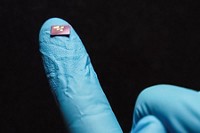Advertisement
Grab your lab coat. Let's get started
Welcome!
Welcome!
Create an account below to get 6 C&EN articles per month, receive newsletters and more - all free.
It seems this is your first time logging in online. Please enter the following information to continue.
As an ACS member you automatically get access to this site. All we need is few more details to create your reading experience.
Not you? Sign in with a different account.
Not you? Sign in with a different account.
ERROR 1
ERROR 1
ERROR 2
ERROR 2
ERROR 2
ERROR 2
ERROR 2
Password and Confirm password must match.
If you have an ACS member number, please enter it here so we can link this account to your membership. (optional)
ERROR 2
ACS values your privacy. By submitting your information, you are gaining access to C&EN and subscribing to our weekly newsletter. We use the information you provide to make your reading experience better, and we will never sell your data to third party members.
Analytical Chemistry
Tracking Mercury Levels Through Fish Scales
Environmental Pollutant: Novel combination of techniques provides a fast, sensitive method to measure the toxic metal
by Rajendrani Mukhopadhyay
October 19, 2010

Fish accumulate mercury from their surroundings, so scientists often sample them to examine how levels of the toxic metal fluctuate over time. But current mercury measurement methods in fish have low sensitivities and rely on expensive equipment. Researchers at Fisheries and Oceans Canada, a government agency, have now developed a more sensitive approach that measures traces of mercury from a single fish scale (Anal. Chem., DOI: 10.1021/ac1021387).
Much like the way trees add a ring on their trunks each year, fish annually add a ring on to their scales. The new growth records the mercury present in the animal's environment at that time.
Scientists have previously studied whole fish scales by laser ablation combined with inductively coupled plasma mass spectrometry (ICPMS). In this technique, an intense laser beam blasts a sample and then ICPMS measures the abundances of several elements in the vapor. But ICPMS instrumentation costs several hundreds of thousands of dollars and requires nanograms of mercury in the sample.
To make the analysis cheaper and more sensitive, oceanographers Sophia Johannessen and Robie MacDonald and analytical chemist Luc Beaudin replaced ICPMS with cold vapor atomic fluorescence spectrophotometry (CVAFS), a technique that costs about $5,000 in instrumentation and is designed to detect mercury.
Using the new method, the researchers ablated micrometer-sized patches on a fish scale and directed the vapors into a gold-coated chamber to trap the mercury as a mercury-gold amalgam. The scientists measured how much mercury the trap collected by first heating it to about 600 °C to release the mercury as a vapor. Then they made the gas fluoresce by shining ultraviolet light on it; the brighter the fluorescence, the greater the amount of mercury in the sample. With this new technique, the scientists detected mercury levels as low as 1.5 pg.
Besides collecting data on modern mercury levels, the technique could also provide insights on historical mercury concentrations, Johannessen says. Researchers could pull out 10,000-year-old fish scales from ocean sediment cores and then measure their mercury concentrations to watch how the metal's levels changed over time.
Analytical chemist J. Ignacio Garcia Alonso of the University of Oviedo, in Spain, says the method has an impressive detection limit. He adds that besides being cheaper, the new method requires less sample preparation than the mass spectrometry approaches conventionally used to analyze mercury in fish.




Join the conversation
Contact the reporter
Submit a Letter to the Editor for publication
Engage with us on Twitter